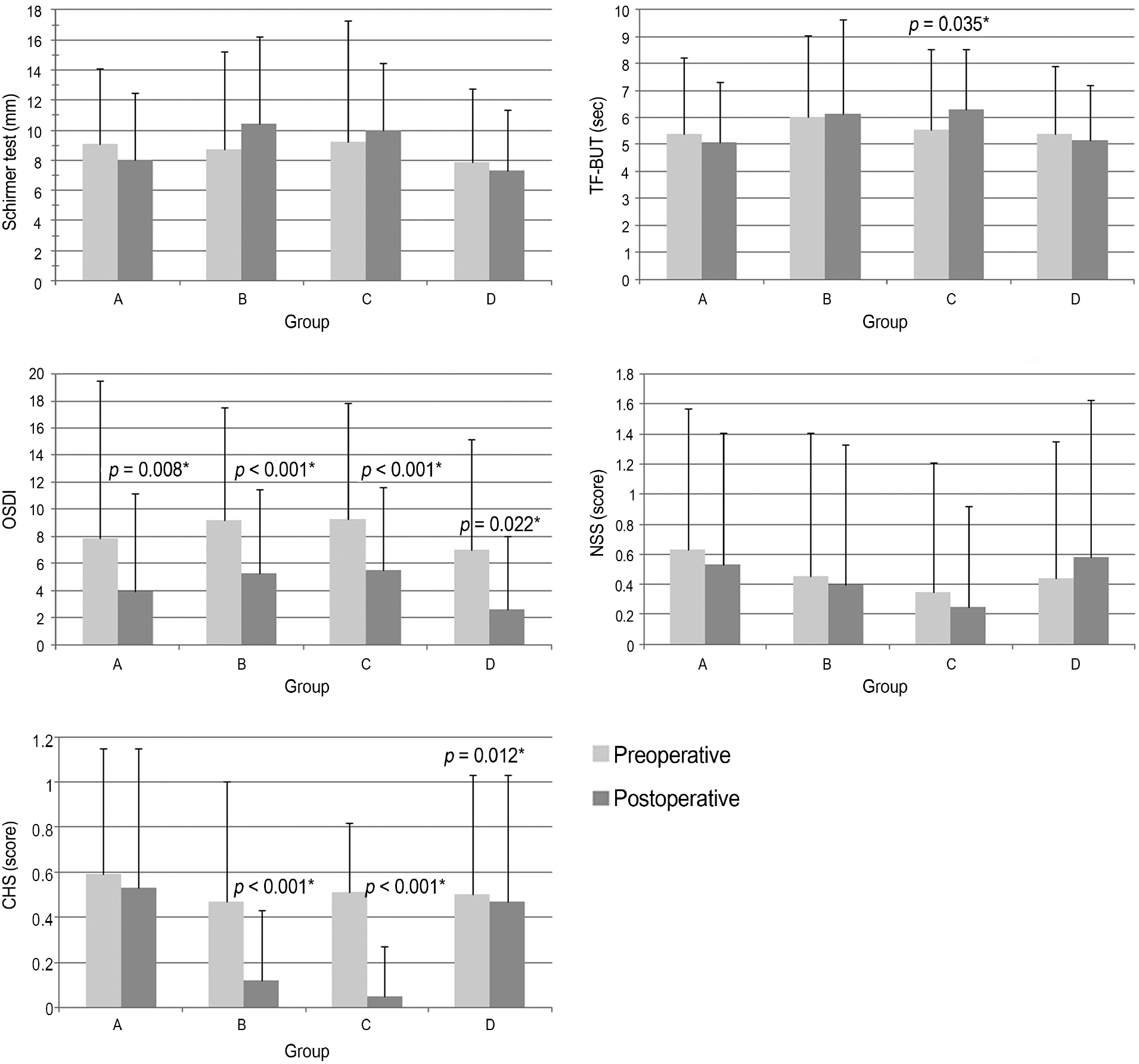1. Snow JC, Kripke BJ, Norton ML. . Corneal injuries during general anesthesia. Anesth Analg. 1975; 54:465–7.

2. Yanagidate F, Dohi S. Corneal abrasion after the wake-up test in spinal surgery. J Anesth. 2003; 17:211–2.

3. Gild WM, Posner KL, Caplan RA, Cheney FW. Eye injuries asso-ciated with anesthesia. A closed claims analysis. Anesthesiology. 1992; 76:204–8.
4. Yu HD, Chou AH, Yang MW, Chang CJ. An analysis of perioper-ative eye injuries after nonocular surgery. Acta Anaesthesiol Taiwan. 2010; 48:122–9.

5. Martin DP, Weingarten TN, Gunn PW. . Performance improve-ment system and postoperative corneal injuries: incidence and risk factors. Anesthesiology. 2009; 111:320–6.
6. Moos DD, Lind DM. Detection and treatment of perioperative cor-neal abrasions. J Perianesth Nurs. 2006; 21:332–8. quiz 339-41.

7. Roth S, Thisted RA, Erickson JP. . Eye injuries after nonocular surgery. A study of 60,965 anesthetics from 1988 to 1992. Anesthesiology. 1996; 85:1020–7.

8. Orlin SE, Kurata FK, Krupin T. . Ocular lubricants and corneal injury during anesthesia. Anesth Analg. 1989; 69:384–5.

9. Batra YK, Bali IM. Corneal abrasions during general anesthesia. Anesth Analg. 1977; 56:363–5.

10. Grixti A, Sadri M, Watts MT. Corneal protection during general an-esthesia for nonocular surgery. Ocul Surf. 2013; 11:109–18.

11. Grover VK, Kumar KV, Sharma S. . Comparison of methods of eye protection under general anaesthesia. Can J Anaesth. 1998; 45:575–7.

12. Boggild-Madsen NB, Bundgarrd-Nielsen P, Hammer U, Jakobsen B. Comparison of eye protection with methylcellulose an paraffin ointments during general anaesthesia. Can Anaesth Soc J. 1981; 28:575–8.
13. Siffring PA, Poulton TJ. Prevention of ophthalmic complications during general anesthesia. Anesthesiology. 1987; 66:569–70.

14. Cucchiara RF, Black S. Corneal abrasion during anesthesia and surgery. Anesthesiology. 1988; 69:978–9.

15. Schmidt P. Bøggild-Madsen NB Protection of the eyes with oph-thalmic ointments during general anaesthesia. Acta Ophthalmol (Copenh). 1981; 59:422–7.
16. Ganidagli S, Cengi M, Becerik C. . Eye protection during gen-eral anaesthesia: comparison of four different methods. Eur J Anaesthesiol. 2004; 21:665–7.

17. Foulks GN. Challenges and pitfalls in clinical trials of treatments for dry eye. Ocul Surf. 2003; 1:20–30.

18. Schulze MM, Hutchings N, Simpson TL. The perceived bulbar redness of clinical grading scales. Optom Vis Sci. 2009; 86:E1250–8.

19. Pflugfelder SC, Tseng SC, Sanabria O. . Evaluation of sub-jective assessments and objective diagnostic tests for diagnosing tear-film disorders known to cause ocular irritation. Cornea. 1998; 17:38–56.

20. Cross DA, Krupin T. Implications of the effects of general anes-thesia on basal tear production. Anesth Analg. 1977; 56:35–7.

21. Krupin T, Cross DA, Becker B. Decreased basal tear production as-sociated with general anesthesia. Arch Ophthalmol. 1977; 95:107–8.
22. Cho JK, Byon D, Lee HS. Decreased basal tear production asso-ciated with general anesthesia. J Korean Ophthalmol Soc. 1999; 40:683–7.
23. Krannig HM, Rohde-Germann H, Straub W. Therapy of corneal erosions and 'dry eye' with Solcoseryl and Vitasic eye drops. Ophthalmologica. 1989; 199:100–5.

24. Kuninaka T, Senga Y, Senga H, Weiner M. Nature of enhanced mi-tochondrial oxidative metabolism by a calf blood extract. J Cell Physiol. 1991; 146:148–55.

25. Studer O. A comparative clinical study of Solcoseryl Eye-Gel and Cysteine Eye-Gel 2.4% in the treatment of foreign-body injuries of the cornea. Ophthalmic Res. 1984; 16:179–84.

26. Brodwall J, Alme G, Gedde-Dahl S. . A comparative study of polyacrylic acid (Viscotears) liquid gel versus polyvinylalcohol in the treatment of dry eyes. Acta Ophthalmol Scand. 1997; 75:457–61.

27. Smolle M, Keller C, Pinggera G. . Clear hydro-gel, compared to ointment, provides improved eye comfort after brief surgery. Can J Anaesth. 2004; 51:126–9.

28. Hardberger R, Hanna C, Boyd CM. Effects of drug vehicles on oc-ular contact time. Arch Ophthalmol. 1975; 93:42–5.

29. Shrewsbury RP, Swarbrick J, Newton KS, Riggs LC. Influence of ophthalmic formulations on sodium cromoglycate disposition in the albino rabbit eye. J Pharm Pharmacol. 1985; 37:614–7.

30. Demers P, Thompson P, Bernier RG. . Effect of occlusive pres-sure patching on the rate of epithelial wound healing after photo-refractive keratectomy. J Cataract Refract Surg. 1996; 22:59–62.

31. Mondino BJ, Zaidman GW, Salamon SW. Use of pressure patching and soft contact lenses in superior limbic keratoconjunctivitis. Arch Ophthalmol. 1982; 100:1932–4.

32. Komnenou AT, Kazakos GM, Savvas I, Thomas AL. Evaluation of aqueous tear production in dogs after general anaesthesia with me-detomidine-propofol-carprofen-halothane. Vet Rec. 2013; 173–4142.

33. Shepard MK, Accola PJ, Lopez LA. . Effect of duration and type of anesthetic on tear production in dogs. Am J Vet Res. 2011; 72:608–12.

34. Choi JH, Kim JH, Li Z. . Efficacy of the mineral oil and hyalur-onic acid mixture eye drops in murine dry eye. Korean J Ophthalmol. 2015; 29:131–7.






 PDF
PDF ePub
ePub Citation
Citation Print
Print


 XML Download
XML Download